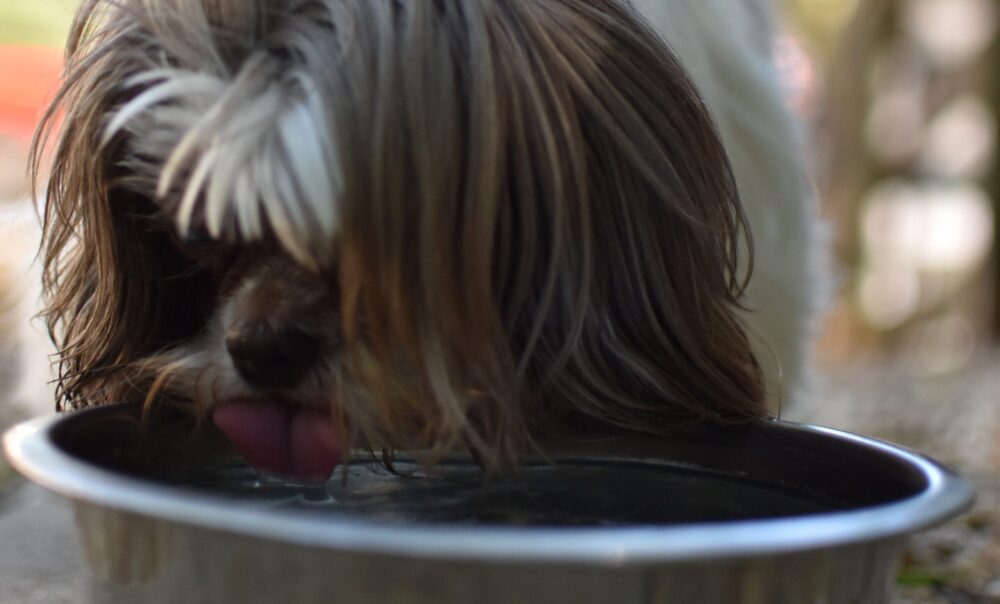From Rick and Anita:
We adopted Frick three years ago and he didn’t have a problem with heat at that time. Now that he is 13 it appears he may have a heat tolerance issue. We’ve been reading about “brachycephalic” but he hasn’t been officially diagnosed. Do you have experience with this type of condition? We’ve read about “cooler dog harnesses” but not sure if they would work as expected.
Thank you so much for sharing about Frick! At 13, he’s definitely earned some extra TLC, especially in the heat. It’s not uncommon for dogs to develop heat sensitivity as they age, even if they were fine before—senior pups can have a more challenging time regulating their body temperature.
We are very aware that some of our residents tolerate the heat better than others, so we ALWAYS keep an extra eye on pups like Tator, who is a shihtzu with advanced airway issues. Something we have learned with our experience with Tator, is that if it’s just too hot and humid, it’s not worth the risk of having him go potty outside, so we make sure he always has a clean diaper and keep him inside, safe and secure in a pen covered with potty pads!! Just a few minutes outside could be detrimental to his health.
Brachycephalic breeds (like Pugs, Bulldogs, and Shih Tzus) do tend to struggle more in the heat due to their shorter airways, but even non-brachycephalic dogs can experience similar issues as they get older. It’s a good idea to have your vet take a look, just to rule out any underlying concerns.
As for cooler dog harnesses, we’ve seen some success with them—especially the types you soak in water before walks. They work through evaporative cooling and can definitely help make outdoor time more comfortable. Just be sure to pair it with shaded routes, lots of water, and shorter outings during the hottest parts of the day.
🧊 Cooling Products for Dogs
1. Cooling Vests or Harnesses
• Examples: Ruffwear Swamp Cooler, Hurtta Cooling Vest
• Soak them in water, wring them out, and they provide evaporative cooling. Great for walks or outdoor time.
2. Cooling Mats or Beds
• Examples: Green Pet Shop Cooling Mat, Arf Pets Cooling Mat—we have used these in the past, and they definitely feel cool to the touch!
• Pressure-activated mats that don’t require freezing or electricity—perfect for indoor lounging.
3. Cooling Bandanas or Collars
• Examples: All For Paws Chill Out Ice Bandana, Canada Pooch Chill Seeker Cooling Bandana
• Lightweight and great for shorter outings or just relaxing in the yard.
4. Elevated Cooling Beds
• Examples: Coolaroo Elevated Pet Bed – The dogs love these! Even when it’s not hot outside, they love to lounge on them as they keep pressure off their little joints, which I’m sure feels great!
• Keeps your dog off hot ground and allows air to circulate underneath.
5. Pet Fans or Cooling Crates
• Battery-powered fans or crates with built-in ventilation to keep them cool while resting or traveling.
🍉 Treats & Hydration Tips
1. Frozen Treats
• Try DIY frozen dog-safe fruit treats (like watermelon cubes) or store-bought options like Frosty Paws. We also have volunteers fill a hollow femur bone with peanut butter and plain yogurt, and then stick them in the freezer. They go nuts for these!
2. Ice Cubes in Water Bowl
• Keeps water cooler and some dogs love playing with the cubes too!
3. Pet Water Fountains
• Keeps water fresh and cool; some dogs drink more with a flowing source.
☀️ Daily Routine Adjustments
• Walk early morning or late evening when temperatures are lowest. We always avoid playtimes during the middle of the day, when it’s usually the hottest, and we sometimes close up the pet doors if it’s dangerously hot so the dogs don’t take naps in the scorching heat!
• Stick to shady areas during walks! During the summer, volunteers install/hang up shades over the places where the pups like to hang out and go potty. This helps to keep our turf yards from soaking up the intense sun rays and makes their outings much more comfortable.
• Watch for signs of overheating, such as excessive panting, drooling, disorientation, or bright red gums. We constantly check on our pups for overheating. Since they are older and more at risk, it’s essential to know the signs to watch out for.

